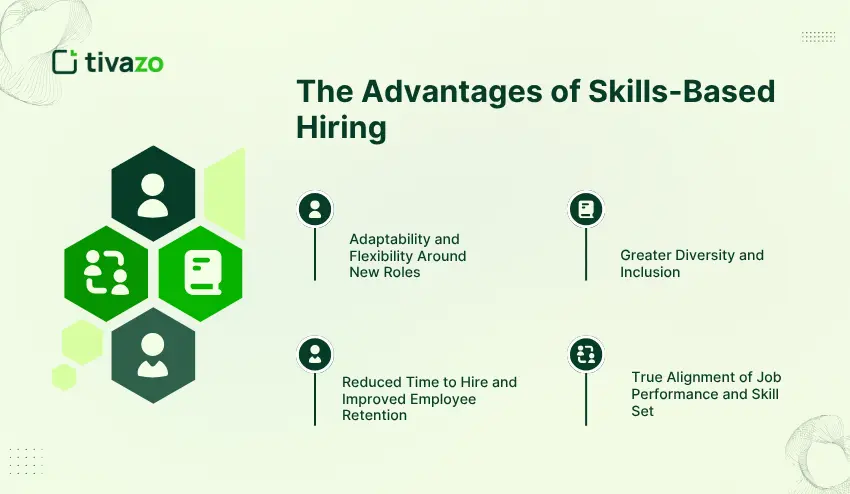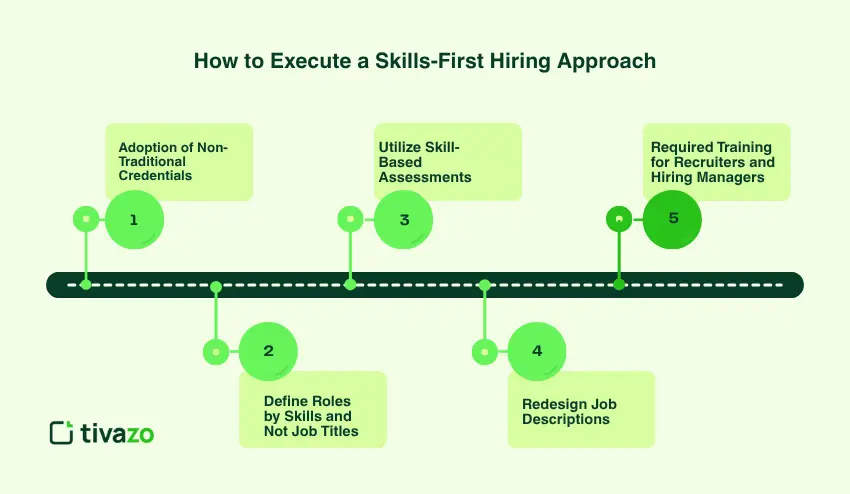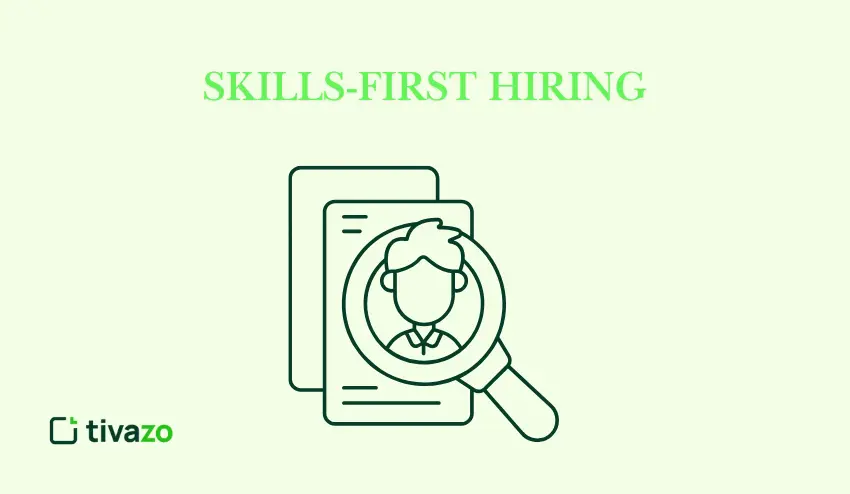Hiring practices have historically revolved around degrees, certifications, and job titles to determine candidates’ potential. However, many roles today actually require skill sets that cannot be recognized or demonstrated by simply having a resume or a diploma. This turnover has led to the rise of skills-based hiring, which emphasizes what you can do, rather than what your qualifications are.
Skills-first hiring is becoming more of the new normal because people can match better talent to real job task demands. It allows companies to tap into a larger pool of candidates, improves diversity, and opens the doors to hire talent ready to contribute from day one. For job seekers, it continues the trend of highlighting real-world abilities vs just the formality of a diploma.
This guide breaks down what a skills-first hiring approach is, why it is important, how companies are incorporating skills into hiring processes, and what candidates can do to excel in a skills-first relationship. You will understand how this model of hiring is changing the future landscape of hiring, allowing for a more equitable, efficient and competitive applied employment process.
What Is Skills-First Hiring?

Skills-first hiring is a recruitment methodology that emphasizes the capabilities and skills of candidates instead of old-fashioned credentials, such as degrees or titles from previous jobs. Employers will evaluate whether the candidate has the abilities to perform the job, rather than their academic background and years of experience, or working in a specific role.
This approach contrasts with traditional hiring, which tends to be based on formal qualifications (credentials), resumes, and interviews that only focus on candidates’ past experience. In a skills-first approach, however, employers may assess skills and competencies through a number of different ways, such as assessments, assessments, portfolios, or real-world tasks/projects, to define candidates’ capabilities.
Companies adopt skills-first hiring in order to ensure that the employees they select can actually do the work that is required, rather than just assume competence from a degree or past position. Skills-first hiring also helps reduce bias, as it relies on objective indicators (measurable skills) rather than confusing indicators (such as the name of a school or a person’s age).
Why Hiring For Skills Is Important Today
The contemporary workforce is changing rapidly, and traditional hiring methods are unable to keep pace. There are skill shortages, technological advancements, and new job requirements that can gradually become outdated by degree. By hiring for skills, organizations can screen for individuals who will contribute immediately to their workplace, improving productivity while decreasing ramp-up time.
Hiring for skills can also help with more inclusion and diverse hiring. If candidates are simply screened based on degrees or with no attention paid to the prestige of the degree-granting institutions, it may inadvertently screen out talented individuals from underrepresented backgrounds. Screening for skills will bring in a wider talent pool, thus reducing candidate bias and leading to a fair workplace.
Furthermore, companies are evolving into organizations that rely predominantly on automation and digital transformation. Some of the roles that have been created did not even exist a decade ago. Many of those positions are technical or practical in nature and will not provide individuals with the same education as a traditional degree. If companies are engaging in a skills-based model, they are ensuring that they will stay competitive, future-proof their workforce, and ensure that employees have the competencies to be successful in a changing organization.
The Advantages of Skills-Based Hiring
Whether you like it or not, skills-based hiring provides multiple advantages for employers and candidates alike. By recognizing what a candidate can do, an organization can make objectively smarter hiring decisions while building stronger, more effective, and more cohesive teams.

- Adaptability and Flexibility Around New Roles
As the world evolves, employees will begin to shift and adapt to new roles that will require skills that have not been taught to them in a formal educational setting. Skills-based hiring leads to super-fast identification of candidates capable of quickly adapting and learning new skills, all while future-proofing the talent base for organizations. - Greater Diversity and Inclusion
Recruiting and hiring based on skills versus educational attainment and previous job titles allows the organization to reduce bias and traditional barriers. This opens doors for candidates who may have entirely different backgrounds and experiences than traditional candidates. Ultimately, they will help build a more live, diverse, and innovative talent base. - Reduced Time to Hire and Improved Employee Retention
Hiring for skills versus credentials, which is discussed above, allows organizations to hiring on the job quickly. Hiring for skill tends to yield a better employee for the role, and employees who fit well into the job can equate to improved satisfaction and less turnover. - True Alignment of Job Performance and Skill Set
Skills-based hiring yields employees that are truly competent and capable of performing the skill required by the job. The end result of hiring for skills is improved productivity, project outcomes, and collaboration among co-workers. Teams can begin to contribute to value within their organizations from day one with this approach.
How to Execute a Skills-First Hiring Approach
Executing a skills-first hiring plan takes planning and execution. Organizations must change the focus away from credentials and rely on authentic abilities. Every step of the hiring process must evaluate authentic skills.

- Adoption of Non-Traditional Credentials
As an organization identifies potential candidates, it’s valuable to pursue certifications, portfolios, bootcamps or real work projects as evidence of expertise. It’s likely that skills learned from these methods may be comparable to those learned in traditional degrees. - Define Roles by Skills and Not Job Titles
The first step is to analyze the job’s essential functions. It’s important to identify what specific technical, soft and cognitive skills a person needs to be successful, instead of mentioning degrees or prior job titles. - Utilize Skill-Based Assessments
Many organizations now include practical testing, simulations, or work-related tasks in their hiring processes. This makes it easy to objectively measure applicant competencies and forecast future job performance. - Redesign Job Descriptions
Write job advertisements that specifically include the appropriate skills, competency, and job outcomes and omit the emphasis on academic qualifications. For example, replace “Bachelor’s in Marketing” with “Expertise in developing and executing multifaceted digital marketing campaigns.” - Required Training for Recruiters and Hiring Managers
All HR professionals need training on how to investigate skills effectively. Structured rubrics should be utilized to measure all candidates, and ensure behavior that could result in bias is curtailed, or at least mitigated.
Skills-First hiring in the Real World.
Skills-first hiring has been used successfully in the talent recruitment and employment outcomes of a few notable corporations. The cases presented here indicate the fact that putting skills over another degree, like a college degree, can be valuable in practice.
- Google
Google evaluates the technical people based on their capacity to be able to solve practical problems and other coding tests instead of depending on their degree qualifications. Consequently, it made Google recognized to employ the best of the best based on the education system and this contributed to a high degree of innovation and team performance. - IBM
IBM has made choices by eliminating degree requirements in certain positions by choice and even focused on skills based measures and online certification of skills. The outcome has been the decrease of time-to-hire in critical positions, and the availability of talent. - Accenture
Accenture, in its turn, has been actively transitioning to testing digital abilities of the applicants via boot camps and proctored projects. Accenture found it more valuable to assess the general skills of employees, such as reasoning and problem solving as their results than certificates. The outcome was a reduced turnover of the employees and a workforce that is more capable of supporting the ever-increasing needs of the clients. - Smaller startups
Many smaller startups literally expect the abilities of the candidates with their portfolios, real-life assignments, and work on projects instead of a resume. This helps the company to scale rapidly whilst hiring people who can start working immediately with the core aspects of the start-up projects.
Implication: Skills-first hiring can improve the efficacy of the hiring process relative to that of the conventional strategy driven by the level of degree acquisition. Besides higher engagement recovery in each hiring, skills-first hiring may also contribute to creating a team of people with various skills and experiences of higher levels of performance. Brands that use skills-based methods of work have been noted to hire new hires faster and achieve stronger results within a team because skills are practiced first.
Challenges in Adopting Skills-First Hiring
Skills-first hiring has many benefits; however, as organizations adapt to skills-first hiring, there will be obstacles to overcome in order for it to be a success.
1. Changing the Way You Think
Many HR teams and managers have always viewed the candidate evaluation process as the search for a degree or job title. Changing this way of thinking takes effort, training, awareness, and communication about the benefits of skills-first.
2. Building Good Assessments
Assessments that measure relevant skills can be complex to create. Companies need to ensure that tests are biased-free, job-relevant, and fair, while not overemphasizing theoretical understanding or using a one-size-fits-all.
3. Avoid Bias When Evaluating Skills
Skill-based assessments can be endorsed with unintentional biases. Organizations will want to review evaluations of kits regularly, include multiple perspectives, and validate the tools to achieve fairness.
4. Fit Into Existing HR Structure
Many recruitment platforms and processes are designed for a traditional way of recruiting. Changing to a skills-first hiring approach may require changing the applicant tracking system, training HR staff, and thinking about the flow of work.
5. Candidate Awareness and Readiness
Some candidates may not be accustomed to hiring based on a skills-first approach and may expect a degree-based selection criteria. It’s important that companies clearly articulate what to expect, outlining the assessment format and competencies being assessed.
While there may be intentional barriers to hiring well with skills-first hiring, a higher degree of alignment, diversity, and performance with skills-first hiring may outweigh the inconvenience of attending to skills-first hiring in a more deliberate, intentional manner.
How Job Seekers Can Prepare for Skills-First Hiring
The change to skills-first hiring opens many possibilities for job seekers, but it also means you’re going to have to demonstrate ability more overtly than you did before. Employers will want to see what you can do instead of relying on degrees or titles.
1. Develop a Skill Portfolio
In a skills-based hiring world, a portfolio is the most powerful way to show your skills. Your portfolio can include projects you have completed, designs or code samples, case studies, and even client testimonials, basically anything that communicates work you have done. Portfolios allow recruiters to review your skills and see how you implement them into projects.
Example: A marketer could share an actual report from a campaign showing past campaign results with an attached analytics dashboard, or a before-and-after report for a campaign.
If you work in tech, GitHub repositories or app prototypes would be great examples.
2. Utilize Online Certifications
Online learning companies like Coursera, LinkedIn Learning, and Google Career Certificates provide an easy and flexible way to gain in-demand skills. Not only do these certifications set you apart as a credentialed professional, they allow you to keep your edge and stay competitive in fast-moving industries such as digital marketing, design, or data analytics.
3. Distinguish Yourself by using Practical Experience
Employers care about practical experience more than they possibly ever have. Think about it: even volunteer projects, internships, and freelance opportunities are all fair game as long as they relate to the skills you will be applying. And when applying for roles, always showcase measurable outcomes – “engagement increased by 40%” or “response time decreased by 20%.” Numbers convey how capable you really are.
Transitioning to a skills-first mindset means purposefully providing evidence demonstrating your competence, rather than merely stating it. The more direct evidence you provide, the more convincing your overall profile will be.
Conclusion
The move towards skills-first hiring goes beyond just a hiring trend; it is an attitude shift in how organizations think about talent. When companies focus on what people can do, instead of what is or is not on a resume, they start to access a wider, more capable, and much more diverse workforce.
For job seekers, that means the ability to take charge of your career development. You do not need to have a normal degree, and you do not need to have a linear career path in order to make an impact. All that matters now is the ability to learn, unlearn, re-learn, adapt, and produce.
For employers, that means you are developing teams that are agile, innovative, and prepared for the new world of work. It promotes fairness, increases engagement, and helps to attract candidates driven by impact rather than credentials.
As the world continues to change, organizations that will thrive will be the ones that champion skills, reward learning, and will engage people to grow not only within a job title, but beyond.




